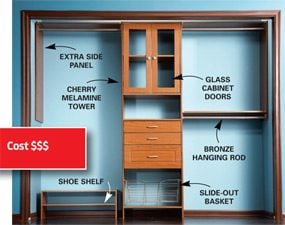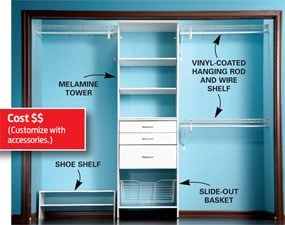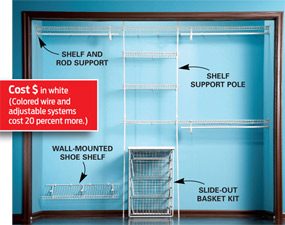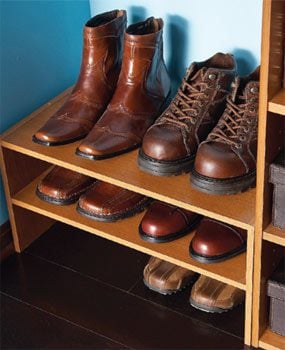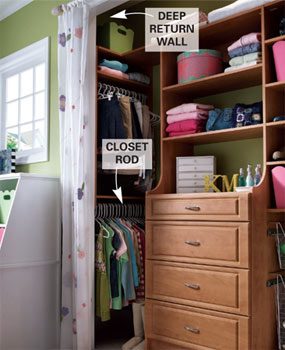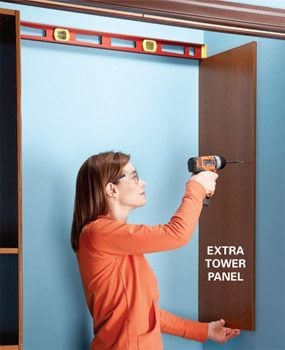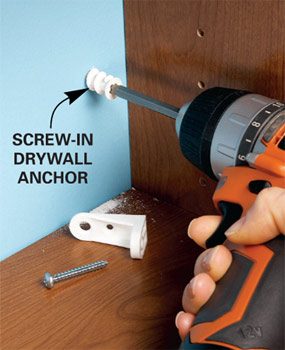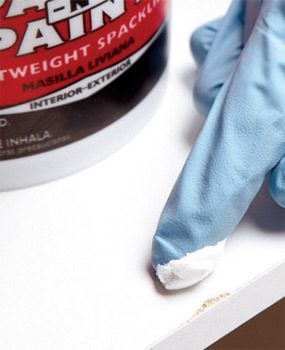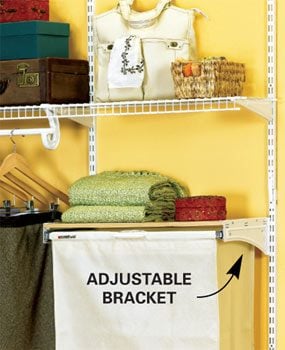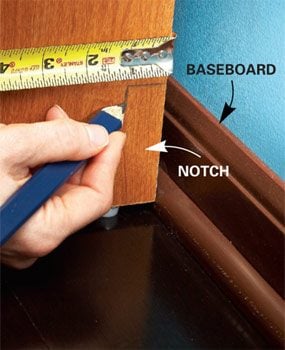Low Cost DIY Closet System
Updated: Jan. 24, 2024A designer closet without the designer price!
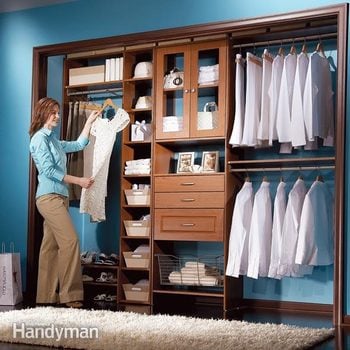
- Time
- Complexity
- Cost
- A full day
- Beginner
- $101–250
Closet System Overview
If you have a messy closet and a free Saturday, this built in closet systems story is for you. Thanks to great-looking ready-made storage components, organizing your bedroom closet has never been easier or more affordable. You’ll find these systems at home centers and online retailers, and in many cases, you can mix and match components from different manufacturers to get exactly what you want.
In this article, we’ll show you three different storage systems designed to organize a standard 8-ft. x 24-in.-deep closet. The built in closet systems range in price from $200 to $500 and use laminate or fixed wire or a combination of the two. Each has the same basic components: a “tower” composed of drawers and shelves that provides the sturdy center of the system; a single closet rod on one side for long clothes; and stacked closet rods on the other side to hang shirts and folded pants. Ready-made systems usually come with easy-to-follow instructions. To make organizing a beautiful closet on a budget a breeze, we’ll focus on design and installation tips that you won’t find in the manufacturer’s instructions.
Beyond Plain White Wire
Affordable ready-made storage components have come a long way in the past few years. They feature better hardware and new finishes and accessories that were once available only on high-end systems. Now your bedroom closet can look great and work like a professionally installed custom closet-at less than half the price.
Three Built In Closet Systems- 3 budget options
What to look for
- Labels don’t tell you much about quality, so try to physically compare components at a store.
- Choose wire systems where moisture is an issue, such as in an entry closet where you’ll be storing wet clothes or boots.
- Combine components and accessories from different systems to create a custom closet (think about all those scarves or ties you’ve got stuffed into a drawer).
- Choose wire shelves that have continuous hanging rods. They allow hangers to slide uninterrupted along the entire rod.
- Adjustable wire uses horizontal tracks, vertical standards and movable brackets that allow for flexibility.
- A vinyl-coated wire is thick and rubbery. An epoxy-coated wire is thinner and harder. Vinyl custom closet cost is a little more, but it resists rust and corrosion and covers welds better than epoxy.
Design tips
Decide what you really need in your closet
Before you buy storage components, remove everything from your closet and decide what you actually need to store in it, what you can store elsewhere (seasonal clothes) and what you can donate to charity. This will help you decide how much shelf, rod and drawer space you’ll need.
Get free design help online
Use manufacturer Web sites to get free help designing and buying ready-made components. Plug in your closet measurements and storage requirements and get storage design plans broken down into individual parts lists, which you can take along to the store or use to buy items online.
Choose the best tower size
Tower components and panel sections are available in standard lengths and widths. Tower components are either 16 or 25 in. wide and 12 to 18 in. deep. If you want more closet rod hanging space, choose the narrower tower. But it makes sense to get the deepest tower possible. Empty space in front is just wasted.
Keep rods at the right height and length
Divide your clothes into short, medium and long and use these measurements for hanging sections:
- Double-hang (when possible) at 42 and 84 in.
- Long-hang at 70 in.
- Medium-hang at 60 in.
- Long-hang pants at 54 in.
Hanging rods longer than 36 in. might bow from too much weight. Add another support bracket or tower unit for longer rods.
Keep folded clothes looking good
Wire custom closet shelving can leave lines in sweaters and delicate fabrics. Use plastic shelf liners to prevent this.
Reposition the tower for sliding doors
If your closet doors overlap in the center, set the tower to one side or put a tower on each side of the closet with hanging space in between.
Save money with doors (instead of drawers)
Slide-out drawers are expensive. If you can’t afford them now, install adjustable or slide-out shelves and add the built in closet drawers later. If you want to conceal items, adding doors (as we did) is less expensive than buying a block of drawers, and lets you instantly see the contents of a shelf.
Use accessories strategically
Choose accessories to complement your lifestyle. Don’t buy a jewelry insert for your drawer if you like to store your earrings on a shelf. If you often hunt for a certain belt or tie, then a hanging belt and tie organizer is a smart buy.
Assembly tips
Get clean cuts in laminate
You can often have laminate shelves cut at the home center where you bought them. If you prefer to cut the shelves yourself, use a sharp 140-tooth plywood circular saw blade for the cleanest cuts.
Remove closet doors
Before installing new storage components, remove the closet doors, if you can, to avoid scratching them and to have the widest possible area to work in.
Read the instructions before you start
Once you buy your storage components, compare the parts list with what is included in the box. If something is missing, you can get it before you begin the installation instead of having to stop in the middle.
Work with a partner
If you need to build a section on the floor, a partner can help you lift and steady the unit while you attach it to the wall.
Cut shorter shelves
To avoid marring closet sidewalls, cut full-length shelves at least 1/2 in. shorter than the length of the closet.
Use a bolt cutter rather than a hacksaw
The manufacturer’s instructions suggest using a hacksaw to cut wire shelving. A hacksaw will work, but a bolt cutter will make for smoother, easier cuts.
Use a pipe cutter to cut hanging rods
Manufacturers also typically suggest using a hacksaw to cut closet poles. A pipe cutter is a better, faster way to make the cut.
Wall-mount the tower if you have thick carpets
Floor-mounted towers work well on hardwood floors and low-pile carpets. If you have uneven closet floors or deep-pile carpets, choose adjustable wall-mounted towers that are supported by standards suspended from a wall-anchored horizontal track. The track and standards are sold separately from the individual tower components.
Install the tower, then the shelves
After you install the tower unit, cut the shelves to complete the system. Tilt the top shelf in from below. A snug-fitting shelf is hard to install from the top.
What You Get From a Pro (Besides a Large Bill)
If you had a closet professional install the laminate storage system, you would get:
A closet system completely customized to your specific space and storage needs.
An installer can present options that you might not think about and also has access to customized components. In addition, installers have access to a greater variety of materials and sizes than those that are available at home centers or online. Consider using a professional installer if you have an unusual closet configuration, obstacles to work around or unique storage requirements.
Higher-quality laminate coating.
Coating thickness is less important in closets, but it can be significant in garage and pantry storage, where the stored items are heavier and can easily damage thinner laminate coatings.
A better warranty.
Most ready-made systems have a one-year limited warranty. Our closet consultant guarantees his installation and materials as long as the client owns the home.
Access to discontinued or specialized products.
Home centers limit their product line and change their in-stock items frequently, so it can be hard to find items they no longer carry. Installers can more easily find discontinued products and colors and have access to a wider range of specialized accessories.
Required Tools for this DIY Closet System Project
Have the necessary tools for this DIY project lined up before you start—you’ll save time and frustration.
- 4-in-1 screwdriver
- Circular saw
- Cordless drill
- Hacksaw
- Jigsaw
- Level
- Tape measure
- Tube cutter
Required Materials for this DIY Closet System Project
Avoid last-minute shopping trips by having all your materials ready ahead of time. Here’s a list.
- Closet system
- Screw-in wall anchors
- Spackle
- Wood putty
